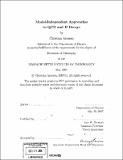Model-independent approaches to QCD and B decays
Author(s)
Arnesen, Christian
DownloadFull printable version (11.30Mb)
Other Contributors
Massachusetts Institute of Technology. Dept. of Physics.
Advisor
Iain W. Stewart.
Terms of use
Metadata
Show full item recordAbstract
We investigate theoretical expectations for B-meson decay rates in the Standard Model. Strong-interaction effects described by quantum chromodynamics (QCD) make this a challenging endeavor. Exact solutions to QCD are not known, but an arsenal of approximation techniques have been developed. We apply effective field theory methods, in particular the sophisticated machinery of the soft-collinear effective theory (SCET), to B decays with energetic hadrons in the final state. SCET separates perturbative interactions at the scales mb and ... from hadronic physics at AQCD by expanding in ratios of these scales. After a review of SCET, we construct a complete reparametrization-invariant basis for heavy-to-light currents in SCET at next-to-next-to-leading order in the power-counting expansion. Next we classify AQCD/mb corrections to non-leptonic B - M1 M2 decays, where M1,2 are charmless mesons (flavor singlets excluded). The leading contributions to annihilation amplitudes as well as the leading "chirally enhanced" contributions are calculated and depend on twist-2 two-parton and twist-3 three-parton distributions. We demonstrate that non-perturbative strong phases in annihilation are suppressed. Using simple models, we find that the three-parton and two-parton terms have comparable magnitude, both consistent with the expected size of power corrections. Finally, we present a method for determining Vub from B --> [pi] data that is competitive with inclusive methods. At large q2, the form factor is taken from unquenched lattice QCD. At q2 = 0, we impose a model-independent constraint obtained from B --> [pi][pi] using SCET, and the form factor shape is constrained using QCD dispersion relations. Theory error is dominated by the input points, with negligible uncertainty from the dispersion relations.
Description
Thesis (Ph. D.)--Massachusetts Institute of Technology, Dept. of Physics, 2007. Includes bibliographical references (p. 169-182).
Date issued
2007Department
Massachusetts Institute of Technology. Department of PhysicsPublisher
Massachusetts Institute of Technology
Keywords
Physics.